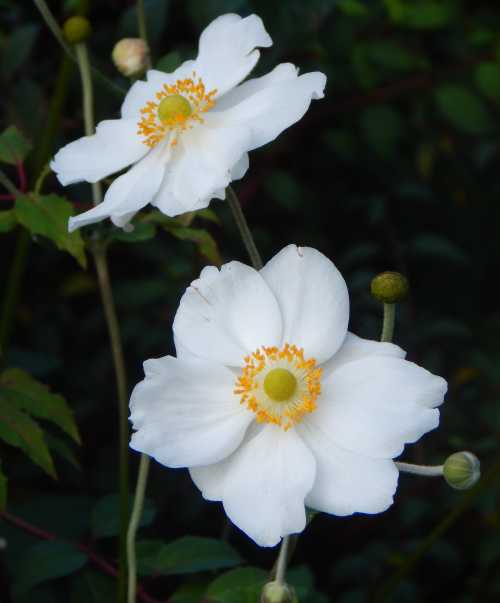Bees Love Japanese Anemones - A Lovely Autumn Flowering Plant For Bees
As I write, it’s October. Some of the flowers in my garden remain in bloom, although they are mostly past their best. Still hanging on is the lovely Japanese anemone.
I love to
watch bees on Japanese anemone, and indeed I captured what I hope will be some
nice video footage contrasting the foraging styles of bumble bees and honey
bees when visiting a large patch of it in my garden. I hope
to add it to this page later.
In contrast with honey bees, bumble bees make a loud buzzing sound as they shake the abundant pollen from the anthers of the flower. Honey bees are quiet in comparison, yet their hind legs are laden with pollen nevertheless.
Both types
of bees seem to be very keen on the Japanese anemone in my garden, and the
clump of pink flowers on tall, willowy (yet fairly sturdy) stems provide lots
of pollen for bees from late July-August through September and into October.
This is ideal timing for queen bumble
bees needing to build up their food reserves ready for hibernation, and for worker honey bees foraging for the hive or nest.
 Bumble bees like Japanese anemones too.
Bumble bees like Japanese anemones too.
Other
pollinators feed on Japanese anemones too, notably hover flies.
 Apparently, hover flies don’t mind sharing a flower head with a bee.
Apparently, hover flies don’t mind sharing a flower head with a bee.
Growing
Japanese Anemones For Bees
Japanese
anemones are fantastic for bees especially as they provide lots of pollen. However, I feel it is important to warn you
from my own experience: this plant can be a bit
thuggish in the garden to say the least, spreading rapidly through shoots that
can quickly take over an area before you can say ‘Jack Flash!’.
I first purchased
a couple of sprigs at a plant fair several years ago, and without asking too
many questions. I had seen them in
gardens, knew they were loved by bees, and merrily set about adding them to our
flower border.
I was initially very pleased when the sprigs quickly established themselves and produced flowers the following year, but must admit, I was not quite prepared for how rapidly they would spread – taking into account that my garden is rather small.
That’s not to say that I would necessarily advise against this plant, especially if:
- It
is not considered invasive in your country.
- You
have a large flower border to fill and you need something that will spread quickly
and provide some height.
- You
want a herbaceous perennial for your flower border.
- You
have an enclosed border or large container that is appropriate for this plant.
- You
have time to keep on top of it, so that you can keep removing growth and
control it so that it does not spread too rapidly.
- You want a mass of pretty blooms that feed the bees over a long period and through the autumn.
 Flowers of Japanese anemone look very pretty standing tall above the foliage.
Flowers of Japanese anemone look very pretty standing tall above the foliage.Other than that, in my experience, Japanese anemone is easy to care for. I simply planted the couple of sprigs into the soil and left it at that. It's pretty adaptable to most soil conditions (although it's not keen on very wet soil) and likes sunshine but is happy in partial shade.
The plant dies back in the winter, and new growth appears late Spring, with a fairly tall, roundish clump of leaves. Later, the plant throws up pretty flower stalks that stand tall above the foliage.
Which Japanese Anemone Varieties Do Bees Like?
Growing in my garden, I have Anemone hupehensis - 'Hadspen Abundance'.
I also love Anemone hupehensis - japonica 'Prinz Heinrich'.
Whilst I don't have this variety in my garden, I have seen it elsewhere - hence I was able to take photographs. In comparison with the variety in my own garden, it's a deeper pink and has more petals which are slightly elongated.
 Anemone hupehensis - japonica 'Prinz Heinrich' is also attractive to bees.
Anemone hupehensis - japonica 'Prinz Heinrich' is also attractive to bees.Other varieties you could try:
- Anemone hupehensis 'Bowles's Pink' - Japanese anemone 'Bowles's Pink'
- Anemone hupehensis var. japonica 'Pamina' - Japanese anemone 'Pamina'
- Anemone hupehensis 'Praecox' Japanese anemone 'Praecox'
- Anemone hupehensis var. japonica 'Splendens' - Japanese anemone 'Splendens'.
 A white variety, Anemone × hybrida 'Honorine Jobert'.
A white variety, Anemone × hybrida 'Honorine Jobert'.
If you want a white variety, try Anemone × hybrida 'Honorine Jobert'.
I have certainly witnessed hover flies feeding on them, although I am not sure how popular they are with bees.
 Hover fly on white Japanese anemone.
Hover fly on white Japanese anemone.More articles about bees and plants
- 30 Fantastic Garden Flowers For Bees 30 Fantastic Garden Flowers For Bees - recommendations for the perfect bee garden
- 20 Flowering Shrubs For Bees 20 Flowering Shrubs For Bees: wonderful tried and tested flowering shrubs loved by bees and other pollinators.
- Which Roses Do Bees Like? Which Roses Do Bees Like? Bees typically like the beautiful open flowers of wild roses and rosa rugosa (commonly called beach rose)
- Herb Planting For Bees Herb planting for bees: a list of herbs loved by bees, butterflies and other pollinators.